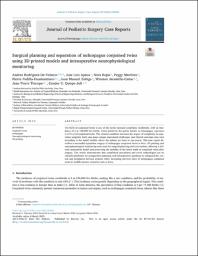| dc.contributor.author | Rodriguez-De-Velasco, Andres | |
| dc.contributor.author | Apaza, José Luis | |
| dc.contributor.author | Rojas, Nora | |
| dc.contributor.author | Martinez, Peggy | |
| dc.contributor.author | Padilla-Huamantinco, Pierre | |
| dc.contributor.author | Zuñiga, Juan Manuel | |
| dc.contributor.author | Jaramillo-Cañas, Winston | |
| dc.contributor.author | Tincopa, Jean Pierre | |
| dc.contributor.author | Quispe-Juli, Cender U. | |
| dc.date.accessioned | 2023-05-22T18:45:22Z | |
| dc.date.available | 2023-05-22T18:45:22Z | |
| dc.date.issued | 2023-03-08 | |
| dc.identifier.uri | https://hdl.handle.net/20.500.13053/8609 | |
| dc.description.abstract | “The birth of conjoined twins is one of the rarest neonatal conditions worldwide, with an incidence of 1 in 100,000 live births. Twins joined by the pelvis, known as ischiopagus, represent
6–11% of all conjoined twins. This clinical condition increases the degree of complexity in separation surgeries. Each case poses unique anatomical challenges, and clinical outcomes may vary
according to the health facility where the infants are born or can access. This case report describes a successful separation surgery of ischiopagus conjoined twins in Peru. 3D printing and
neurophysiological monitoring were used for surgical planning and intervention, allowing a fullscale anatomical model and preserving the mobility of the lower limbs of conjoined twins after
surgery. This article demonstrates that established procedures and novel technologies can be
valuable platforms for preoperative planning and intraoperative guidance to safeguard the central and peripheral nervous systems while increasing survival rates of ischiopagus conjoined
twins in middle-income countries such as Peru.“ | es_PE |
| dc.format | application/pdf | es_PE |
| dc.language.iso | eng | es_PE |
| dc.publisher | Elsevier Inc. | es_PE |
| dc.rights | info:eu-repo/semantics/openAccess | es_PE |
| dc.rights.uri | https://creativecommons.org/licenses/by/4.0/ | es_PE |
| dc.subject | "Conjoined twins Ischiopagus Neurophysiological monitoring 3D printing " | es_PE |
| dc.title | “Surgical planning and separation of ischiopagus conjoined twins using 3D printed models and intraoperative neurophysiological monitoring“ | es_PE |
| dc.type | info:eu-repo/semantics/article | es_PE |
| dc.identifier.doi | "https://doi.org/10.1016/j.epsc.2023.102604 " | |
| dc.type.version | info:eu-repo/semantics/publishedVersion | es_PE |
| dc.publisher.country | EUA | es_PE |
| dc.subject.ocde | 1.02.00 -- Informática y Ciencias de la Información | es_PE |


